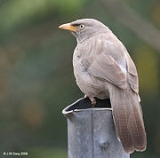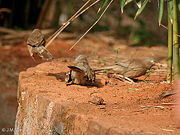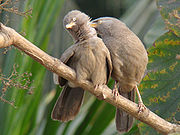
Jungle Babbler
Encyclopedia
The Jungle Babbler is an Old World babbler
found in the Indian Subcontinent
. They are gregarious birds that forage in small groups of six to ten birds, a habit that has given them the popular name of Seven Sisters or Saath bhai in Hindi
with cognates in other regional languages which means "seven brothers".
The Jungle Babbler is a common resident breeding bird in most parts of the Indian Subcontinent and is often seen in gardens within large cities as well as in forested areas. In the past, the Orange-billed Babbler
, Turdoides rufescens, of Sri Lanka
was considered to be a race of this babbler, but is elevated to a species.
_in_kawal,_ap_w_img_1953.jpg) The Jungle Babbler's habitat is forest
The Jungle Babbler's habitat is forest
and cultivation
. This species
, like most babblers, is non-migratory
, and has short rounded wings and a weak flight. The sexes are identical, drably coloured in brownish grey with a yellow-bill making them confusable only with the endemic White-headed Babblers of peninsular India and Sri Lanka. The upperparts are usually slightly darker in shade and there is some mottling on the throat and breast. The race T. s. somervillei of Maharastra has a very rufous tail and dark primary flight feathers.The Jungle Babbler can be separated from the White-headed Babbler by the dark loreal zone between the bill and the eye as well as the lack of a contrasting light crown. The calls of the two species are however distinct and unmistakable. The Jungle Babbler has harsh nasal calls while the White-headed Babbler has high pitched calls. Another babbler that is similarly found in urban areas is the Large Grey Babbler
, however that species has a distinctive long tail with white outer tail feathers.
The Jungle Babbler lives in flocks of seven to ten or more. It is a noisy bird, and the presence of a flock may generally be known at some distance by the harsh mewing calls, continual chattering, squeaking and chirping produced by its members.
 The species was described in 1823 under the name of Cossyphus striatus and was based on a specimen from Bengal. There are several named geographically isolated subspecies that show plumage shade differences. Former race rufescens of Sri Lanka is considered a full species. The widely accepted subspecies include:
The species was described in 1823 under the name of Cossyphus striatus and was based on a specimen from Bengal. There are several named geographically isolated subspecies that show plumage shade differences. Former race rufescens of Sri Lanka is considered a full species. The widely accepted subspecies include:
Some older literature can be confusing due to some incorrect usage such as Whistler (1944, Spolia Zeylanica, 23:131), who used the name affinis (which could be confused with Turdoides affinis when intending to indicate the subspecies of striatus found in peninsular India.
 These birds are gregarious and very social. They sometimes form the core of a mixed-species foraging flock. They feed mainly on insects, but also eats grains, nectar and berries. The groups maintain territories and will defend it against neighbours but will sometimes tolerate them. For their size, they are long lived and have been noted to live as long as 16.5 years in captivity.
These birds are gregarious and very social. They sometimes form the core of a mixed-species foraging flock. They feed mainly on insects, but also eats grains, nectar and berries. The groups maintain territories and will defend it against neighbours but will sometimes tolerate them. For their size, they are long lived and have been noted to live as long as 16.5 years in captivity.
When foraging, some birds take up a high vantage point and act as sentinels. They are known to gather and mob
potential predators such as snakes.
Young birds have a dark iris. Older birds have a pale creamy colour and it has been found that the iris has a dark epithelium which become invisible when the muscle fibres develop in the iris and make the dark basal colours invisible and then appear cream coloured.
They breed throughout the year; peak breeding in northern India has been noted between March–April and July–September. Birds are able to breed after their third year. The nest is built halfway in a tree, concealed in dense masses of foliage. The normal clutch is three or four (but can be up to seven) deep greenish blue eggs. In northern India, birds breeding during June–September tend to be parasitized by the Pied Crested Cuckoo and sometimes by the Common Hawk-cuckoo
. Helpers
assist the parents in feeding the young. Post fledging survival is very high.
Birds fledge and females tend to leave their natal group after about two years. Birds within a group often indulge in allopreening, play chases and mock fights. When threatened by predators, they have been said to sometimes feign death.
notes an incident during the Colonial period in India:
Old World babbler
The Old World babblers or timaliids are a large family of mostly Old World passerine birds. They are rather diverse in size and coloration, but are characterised by soft fluffy plumage. These are birds of tropical areas, with the greatest variety in Southeast Asia and the Indian Subcontinent...
found in the Indian Subcontinent
Indian subcontinent
The Indian subcontinent, also Indian Subcontinent, Indo-Pak Subcontinent or South Asian Subcontinent is a region of the Asian continent on the Indian tectonic plate from the Hindu Kush or Hindu Koh, Himalayas and including the Kuen Lun and Karakoram ranges, forming a land mass which extends...
. They are gregarious birds that forage in small groups of six to ten birds, a habit that has given them the popular name of Seven Sisters or Saath bhai in Hindi
Hindi
Standard Hindi, or more precisely Modern Standard Hindi, also known as Manak Hindi , High Hindi, Nagari Hindi, and Literary Hindi, is a standardized and sanskritized register of the Hindustani language derived from the Khariboli dialect of Delhi...
with cognates in other regional languages which means "seven brothers".
The Jungle Babbler is a common resident breeding bird in most parts of the Indian Subcontinent and is often seen in gardens within large cities as well as in forested areas. In the past, the Orange-billed Babbler
Orange-billed Babbler
The Orange-billed Babbler, Turdoides rufescens, also known as Ceylon Rufous Babbler or Sri Lankan Rufous Babbler is an Old World babbler. The Old World babblers are a large family of Old World passerine birds characterised by soft fluffy plumage...
, Turdoides rufescens, of Sri Lanka
Sri Lanka
Sri Lanka, officially the Democratic Socialist Republic of Sri Lanka is a country off the southern coast of the Indian subcontinent. Known until 1972 as Ceylon , Sri Lanka is an island surrounded by the Indian Ocean, the Gulf of Mannar and the Palk Strait, and lies in the vicinity of India and the...
was considered to be a race of this babbler, but is elevated to a species.
Description
_in_kawal,_ap_w_img_1953.jpg)
Forest
A forest, also referred to as a wood or the woods, is an area with a high density of trees. As with cities, depending where you are in the world, what is considered a forest may vary significantly in size and have various classification according to how and what of the forest is composed...
and cultivation
Tillage
Tillage is the agricultural preparation of the soil by mechanical agitation of various types, such as digging, stirring, and overturning. Examples of human-powered tilling methods using hand tools include shovelling, picking, mattock work, hoeing, and raking...
. This species
Species
In biology, a species is one of the basic units of biological classification and a taxonomic rank. A species is often defined as a group of organisms capable of interbreeding and producing fertile offspring. While in many cases this definition is adequate, more precise or differing measures are...
, like most babblers, is non-migratory
Bird migration
Bird migration is the regular seasonal journey undertaken by many species of birds. Bird movements include those made in response to changes in food availability, habitat or weather. Sometimes, journeys are not termed "true migration" because they are irregular or in only one direction...
, and has short rounded wings and a weak flight. The sexes are identical, drably coloured in brownish grey with a yellow-bill making them confusable only with the endemic White-headed Babblers of peninsular India and Sri Lanka. The upperparts are usually slightly darker in shade and there is some mottling on the throat and breast. The race T. s. somervillei of Maharastra has a very rufous tail and dark primary flight feathers.The Jungle Babbler can be separated from the White-headed Babbler by the dark loreal zone between the bill and the eye as well as the lack of a contrasting light crown. The calls of the two species are however distinct and unmistakable. The Jungle Babbler has harsh nasal calls while the White-headed Babbler has high pitched calls. Another babbler that is similarly found in urban areas is the Large Grey Babbler
Large Grey Babbler
The Large Grey Babbler, Turdoides malcolmi, is an Old World babbler found in India. They are locally common in the scrub, open forest and gardenland. They are usually seen in small groups and are easily distinguished from other babblers in the region by their nasal call and the whitish outer...
, however that species has a distinctive long tail with white outer tail feathers.
The Jungle Babbler lives in flocks of seven to ten or more. It is a noisy bird, and the presence of a flock may generally be known at some distance by the harsh mewing calls, continual chattering, squeaking and chirping produced by its members.
Taxonomy and systematics

- striata ( Dumont de Sainte Croix, 1823) which is found over much of northern India south of the Himalayan foothills extending to Bhutan, Assam, Uttar Pradesh, Himachal Pradesh and northeastern Andhra Pradesh. The form in parts of Orissa orissae said to be more rufous above is usually subsumed into this.
- sindiana ( Ticehurst, 1920) is a paler desert form that is found in the Indus plains of Pakistan and extends into Rajasthan and the Rann of Kutch in India
- somervillei ( Sykes, 1832) is found in the northern Western Ghats south to the Goa GapGoa GapThe Goa Gap is one of the major passes in the Western Ghats, between the Maharashtra and Karnataka sections....
- malabarica ( Jerdon, 1845) is found in the southern Western Ghats
- orientalis ( Jerdon, 1845) is found in peninsular India east of the Western Ghats
Some older literature can be confusing due to some incorrect usage such as Whistler (1944, Spolia Zeylanica, 23:131), who used the name affinis (which could be confused with Turdoides affinis when intending to indicate the subspecies of striatus found in peninsular India.
Behaviour and ecology

When foraging, some birds take up a high vantage point and act as sentinels. They are known to gather and mob
Mobbing behavior
Mobbing in animals is an antipredator behavior which occurs when individuals of a certain species mob a predator by cooperatively attacking or harassing it, usually to protect their offspring. A simple definition of mobbing is an assemblage of individuals around a potentially dangerous predator...
potential predators such as snakes.
Young birds have a dark iris. Older birds have a pale creamy colour and it has been found that the iris has a dark epithelium which become invisible when the muscle fibres develop in the iris and make the dark basal colours invisible and then appear cream coloured.
They breed throughout the year; peak breeding in northern India has been noted between March–April and July–September. Birds are able to breed after their third year. The nest is built halfway in a tree, concealed in dense masses of foliage. The normal clutch is three or four (but can be up to seven) deep greenish blue eggs. In northern India, birds breeding during June–September tend to be parasitized by the Pied Crested Cuckoo and sometimes by the Common Hawk-cuckoo
Common Hawk-cuckoo
The Common Hawk-Cuckoo , popularly known as the Brainfever bird, is a medium sized cuckoo resident in South Asia. It bears a close resemblance to the Shikra, a sparrow hawk, even in its style of flying and landing on a perch...
. Helpers
Helpers at the nest
Helpers at the nest is a term used in behavioural ecology and evolutionary biology to describe a social structure in which juveniles and sexually mature adolescents of either one or both sexes, remain in association with their parents and help them raise subsequent broods or litters, instead of...
assist the parents in feeding the young. Post fledging survival is very high.
Birds fledge and females tend to leave their natal group after about two years. Birds within a group often indulge in allopreening, play chases and mock fights. When threatened by predators, they have been said to sometimes feign death.
In culture
These birds are very common near towns and cities particularly in northern India and are well known for their habit of moving in groups giving them the local name of "Sath Bhai" which means seven brethren but translated by the English in India to "Seven sisters". Visitors to India were very likely to notice these vocal and active birds and Frank FinnFrank Finn
Frank Finn FZS, MBOU was an English ornithologist.Finn was born in Maidstone and educated at Maidstone Grammar School and Brasenose College, Oxford. He went on a collecting expedition to East Africa in 1892, and became First Assistant Superintendent of the Indian Museum, Calcutta in 1894, and...
notes an incident during the Colonial period in India:
Other sources
- Andrews MI & RM Naik (1965) Some observations on flocks of the Jungle Babbler Turdoides striatus (Dumont) during winter. Pavo 3:47-54.
- Naik,RM; Andrews,MI (1966) Pterylosis, age determination and moult in the jungle babbler. Pavo 4(1-2):48-57.
- Andrews,MI; Naik,RM (1966) The body weight and the thyroid and gonadal cycles of the jungle babbler. Pavo 4(1&2):48-57.
- Andrews,MI; Naik,RM (1972) The biology of the jungle babbler. Pavo 08(1&2):1-34.
- Rana,BD (1972) Some observations on food of the Jungle Babbler, Turdoides striatus, and the Common Babbler, Turdoides caudatus in the Rajasthan Desert, India. Pavo 8(1&2):35-44.
- Rana,DB (1985) Abnormality in the testis of Streptopelia decaocto and Turdoides striatus in the Rajasthan desert. Pavo 23(1&2):101-102.
- Suresh,PK; Chaturvedi,CM (1986) Annual endocrine cycles in male babbler, Turdoides somerveillei. Pavo 24(1&2):43-54.
- Parasharya,BM (1986) Early breeding date of Jungle Babbler in Gujarat. Pavo 24(1&2):117-118.
- Inglis,CM (1936) The Bengal Jungle Babbler or "Seven Sisters," Turdoides terricolor terricolor (Hodgson). J. Darjeeling Nat. Hist. Soc. 10(4):117-123
- Ali,S (1974) Jungle Babblers at Pali Hills, Bandra, Bombay 400050. Newsletter for BirdwatchersNewsletter for BirdwatchersNewsletter for Birdwatchers is an Indian periodical of ornithology and birdwatching founded in 1960 by Zafar Futehally, who edited it until 2003. It was initially mimeographed and distributed to a small number of subscribers each month. The editorial board in its early years included Salim Ali,...
. 14(11):5-6. - R. Ray-Chaudhuri, T. Sharma, S. P. Ray-Chaudhuri (1969) A comparative study of the chromosomes of birds. Chromosoma 26(2):148-168
- Mitra, Sarat Chandra (1926-27?) Studies in bird-myths:
- No. {X}: On a probable aetiological myth about the jungle babbler;
- No. {XI}: On an aetiological myth about the Indian house-crow;
- No. {XII}: On three aetiological myths about the spots on the peacock's tail-feathers;
- No. {XIII}: Quarterly Journal of the Mythic Society 17:63-64
External links
- Jungle Babler videos, photos & sounds on the Internet Bird Collection.
- Photo of a leucistic individual

